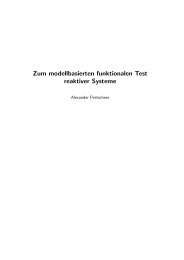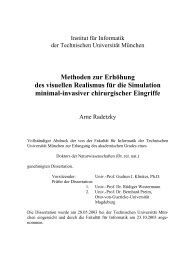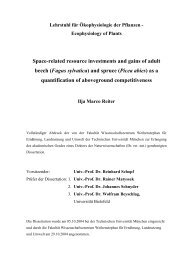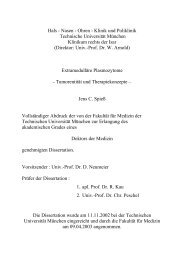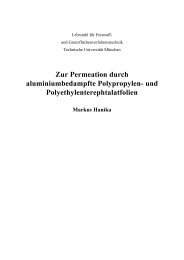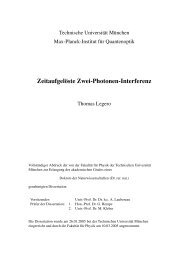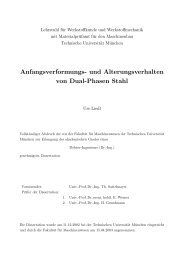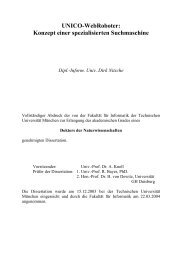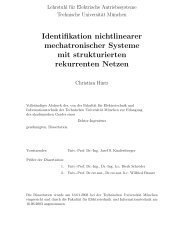Controlling the motion of an atom in an optical cavity
Controlling the motion of an atom in an optical cavity
Controlling the motion of an atom in an optical cavity
You also want an ePaper? Increase the reach of your titles
YUMPU automatically turns print PDFs into web optimized ePapers that Google loves.
24 3.1. Model<br />
operators v<strong>an</strong>ish. This c<strong>an</strong> be seen as follows: The reservoir consists <strong>of</strong> modes which c<strong>an</strong><br />
be described by a harmonical oscillator model. In <strong>the</strong> rotat<strong>in</strong>g wave approximation, <strong>the</strong><br />
noise operators are a l<strong>in</strong>ear comb<strong>in</strong>ation <strong>of</strong> <strong>an</strong>nihilation operators <strong>of</strong> <strong>the</strong> reservoir’s field<br />
modes (MS99). At room temperature, <strong>the</strong> modes associated with visible frequencies are<br />
<strong>in</strong> <strong>the</strong>ir ground state. As <strong>the</strong> <strong>an</strong>nihilation operators yield zero when <strong>the</strong>y are applied to<br />
a ground state, <strong>the</strong> noise operators also yield zero. The temperature <strong>of</strong> <strong>the</strong> reservoir is<br />
assumed to be zero throughout this <strong>the</strong>sis, which is a very good approximation <strong>in</strong> <strong>the</strong><br />
<strong>optical</strong> regime.<br />
F<strong>in</strong>d<strong>in</strong>g <strong>an</strong> exact solution <strong>of</strong> <strong>the</strong>se equationsisbynome<strong>an</strong>seasy. Therefore,as<strong>an</strong><br />
approximation, <strong>the</strong> Hilbert space <strong>of</strong> each two-level <strong>atom</strong> is replaced by <strong>the</strong> Hilbert space<br />
<strong>of</strong> a harmonic oscillator. In <strong>the</strong> follow<strong>in</strong>g, it will be <strong>in</strong>vestigated <strong>in</strong> which cases this<br />
approximation yields correct results.<br />
First, <strong>the</strong> approximation will certa<strong>in</strong>ly fail if <strong>the</strong> population <strong>of</strong> <strong>the</strong> higher excited states<br />
<strong>of</strong> <strong>the</strong> <strong>atom</strong>ic harmonic oscillator is not small. In this case, as those states do not exist <strong>in</strong><br />
reality, <strong>the</strong>re would be a large difference between <strong>the</strong> qu<strong>an</strong>tum state <strong>of</strong> <strong>the</strong> approximate<br />
system <strong>an</strong>d <strong>the</strong> one <strong>of</strong> <strong>the</strong> real system. For a small enough pump parameter η, however,<br />
this will not be <strong>the</strong> case. Therefore, <strong>the</strong> approximation is valid only for small saturation<br />
<strong>of</strong> <strong>the</strong> <strong>atom</strong>s, which c<strong>an</strong> be achieved by a small enough pump strength η.<br />
Second, even for weak excitation, where only lead<strong>in</strong>g order terms <strong>in</strong> η are import<strong>an</strong>t,<br />
<strong>the</strong> coupled-oscillator model c<strong>an</strong> <strong>in</strong>troduce signific<strong>an</strong>t errors when calculat<strong>in</strong>g higher-order<br />
expectation values. For example, it is clear from our <strong>an</strong>satz that <strong>the</strong> exact result σ − j σ − j =0<br />
will not be reproduced <strong>in</strong> <strong>the</strong> simplified <strong>the</strong>ory. Also, one c<strong>an</strong>not hope to f<strong>in</strong>d correct<br />
solutions for <strong>the</strong> second-order photon correlation function, which <strong>in</strong>volves <strong>the</strong> operator<br />
product a † a † aa. The reason is that here <strong>the</strong> lead<strong>in</strong>g order <strong>in</strong> η comes from <strong>the</strong> population<br />
<strong>of</strong> <strong>the</strong> second excited state <strong>of</strong> <strong>the</strong> <strong>cavity</strong> field. In <strong>the</strong> harmonic oscillator model, this<br />
two-photon state couples <strong>in</strong>directly to <strong>the</strong> second excited state <strong>of</strong> <strong>the</strong> <strong>atom</strong>ic harmonic<br />
oscillator, see Fig. 3.2. The strength <strong>of</strong> this coupl<strong>in</strong>g is given by <strong>the</strong> gij <strong>an</strong>d thus does<br />
not v<strong>an</strong>ish with v<strong>an</strong>ish<strong>in</strong>g pump strength η. As <strong>the</strong> second excited state <strong>of</strong> <strong>the</strong> <strong>atom</strong><br />
does not exist <strong>in</strong> <strong>the</strong> exact <strong>the</strong>ory, <strong>the</strong> amplitude <strong>of</strong> <strong>the</strong> two-photon state will also deviate<br />
from <strong>the</strong> correct result, even <strong>in</strong> <strong>the</strong> limit <strong>of</strong> small saturation. However, only expectation<br />
values where <strong>the</strong> lead<strong>in</strong>g-order term <strong>in</strong> η depends on <strong>the</strong> amplitudes <strong>of</strong> <strong>the</strong> first excited<br />
states <strong>of</strong> <strong>the</strong> <strong>atom</strong>ic <strong>an</strong>d <strong>cavity</strong> harmonic oscillators, respectively, will be calculated <strong>in</strong><br />
this chapter. These expectation values will be correct <strong>in</strong> lead<strong>in</strong>g order <strong>of</strong> η. Therefore,<br />
<strong>the</strong> exact equation <strong>of</strong> <strong>motion</strong> (3.4) c<strong>an</strong> be approximated by<br />
˙σ − j = i∆a,jσ − Nc <br />
j − i gij<br />
i=1<br />
∗ ai − γj σ − j + F<strong>atom</strong>,j. (3.5)<br />
To check <strong>in</strong> which regime this approximation is good, <strong>the</strong> steady state <strong>of</strong> <strong>the</strong> system was<br />
calculated numerically for a s<strong>in</strong>gle <strong>atom</strong> <strong>in</strong>side <strong>the</strong> <strong>cavity</strong>, <strong>in</strong>clud<strong>in</strong>g <strong>the</strong> saturation effects.<br />
These calculations <strong>in</strong>dicate that <strong>the</strong> harmonic-oscillator approximation leads to results<br />
24



